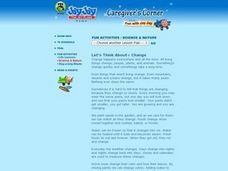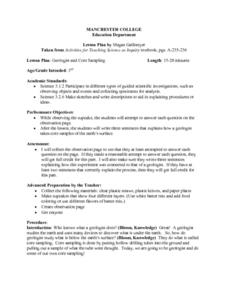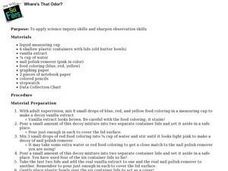Curated OER
Let's Think About... Change
Students observe various examples of "change." They mix paint to cereate new colors, eat bread and then toasted bread, and match baby pictures with pictures of how the same people look in the present. Finally, they watch a bouquet of...
Facing History and Ourselves
Standing Up to Hatred on Cable Street
The final lessons in this section of the Standing Up for Democracy unit ask class members to consider ways they can help create a "more humane, fair, and compassionate environment" in their communities. For context, learners study how...
Curated OER
Different Types Of Bugs
First graders create their own bug that contain the different characteristics that a bug can have. In this bugs lesson plan, 1st graders first list 3 - 5 characteristics before they create their bug.
Curated OER
Planting Phil's Garden
Students explore gardening. In this agriculture lesson, students plan and plant seeds according to the procedure modeled by a "master gardener." Flowers are distributed at a local retirement home.
Curated OER
Field Of Beans
High schoolers investigate the concept of crop farming. They plant small fields to test different theories of agriculture. Students keep care over the fields, including pest and weed control. High schoolers make and record daily...
Curated OER
Science: Bugs and Body Parts
Students determine the function of various insect parts they have observed. Using descriptive words, they explain the insects' characteristics and draw pictures of them. The lesson concludes with students writing short sentences...
Curated OER
Electricity/Magnetism
Second graders experiment with ballons to see which objects will cling and which objects will not. They use an assortment of objects, paper clips, pennies, button, scraps of paper, or puffed cereal. They make predictions and record results.
Curated OER
Is It Hot in the Light?
Third graders make observations about the temperature of items in direct sunlight. In groups, they discuss why asphalt, brick and cement are warmer than items surrounding them. To end the lesson, they examine how heat transfers energy...
Curated OER
Understanding Lava Layers
Seventh graders trace the lava flow of an erupting volcano. In this earth science lesson, 7th graders experiment using baking soda and vinegar. They record and share their observations.
Curated OER
Cultural Anthropology Study Using the Fundamentals of Geography and GPS
Students, in groups, operate the GPS unit, plotting each head stone with accompanying description. Two other students to log in data that corresponds to the given points. One student to note general observations
Curated OER
Feeding Paramecia
Young scholars prepare a slide of Paramecium cultures and observe (through a microscope) the organism's thin transparent membrane and what happens as they "feed" them stained yeast cells. They sketch the path the ingested yeast takes as...
Curated OER
Pear-Shaped Bottle
Students describe the designs on this Chinese ceramic bottle and analyze and discuss the shape of the piece. They describe how art from China arrived in Mexico during the viceregal period. Students create their own blue monochromatic...
Curated OER
Animal Track Mural
Students create a mural depicting who they are. They observe and describe animals in their local environment and relate themselves to an animal. They also discuss how animals show proof of them being in a certain area.
Curated OER
Understanding Justice, Kindness and Tolerance
Ninth graders consider the implications of racism and prejudice. In this character education lesson, 9th graders participate in a classroom activity that requires them to consider how self-deception and self-betrayal contribute to racism.
Curated OER
Launching Rockets
Second graders discuss experiences of watching a rocket launch either on television or in person before making paper rockets. They make and color rockets which they attempt to launch using a strong breath blown through a straw at the...
Curated OER
Summer Scientists
In this lesson, students discuss and reocrd what makes an object living or nonliving. The students then chart the lists of living and nonliving objects. Teacher allows students oportunity to go outside and look for living and ninliving...
Curated OER
Geologist and Core Sampling
Third graders observe a cupcake and attempt to answer each question on the observation page. They write three sentences that explains how a geologist takes core samples of the earth's surface. Students make sketches and write...
Curated OER
Trees for Tomorrow
Students examine how to plan for prudent use of trees so that we never run out of this natural resource. They determine what the oldest wooden object in their home is and draw picture of it. They observe a cross section of a tree and...
Curated OER
Little Sprout
Students plant seeds. In this producers lesson, students compare plants and list what they have in common. They discuss what plants need in order to grow. Students then plant seeds and observe them as they grow.
Curated OER
Every Picture Tells A Story 2
Students view various images designed to create a sense of disequilibrium in visual perception. They view the images, decide what they see in each, record their ideas, and write stories based upon their observations.
Curated OER
Data Collection and Record Keeping. Measuring Larval Growth and Development
Learners keep data records of the growth of Monarch larvae. The observations are made with the change of each stage of development. The observations are to stimulate the answering of questions about biological development.
Curated OER
Hatching Brine shrimp
Second graders investigate the life cycle using brine shrimp as an example. They conduct observations by watching the shrimp hatch out of cysts. Students design simple experiment to structure an observation. The experiment is approved...
Curated OER
Where's That Odor?
Students use various substances to experiment with odors and their potency. They sharpen their observational skills.
Curated OER
Speleothem Formations
Students examine how speleothem formations can be simulated. Students follow directions carefully in this laboratory experiment, and keep a written account of everything they observe. After five days, the students share their experiment...























